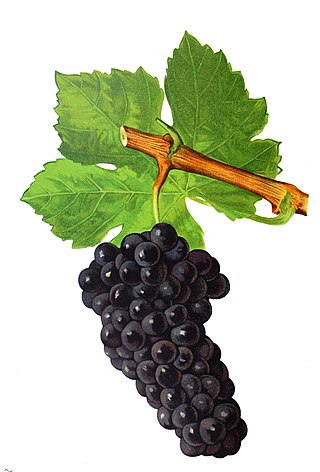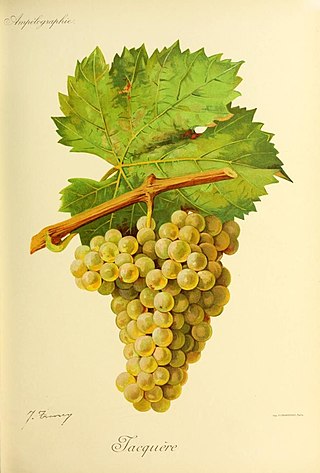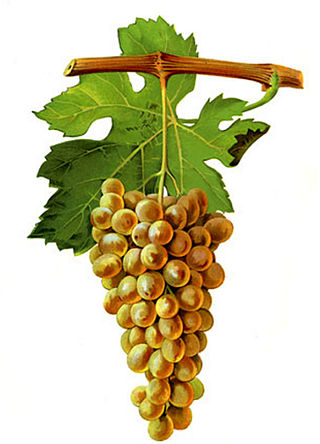Related Research Articles

Durif is a variety of red wine grape primarily grown in Australia, California, France, and Israel. Since the end of the 20th century, wineries located in Washington's Yakima River Valley, Maryland, Arizona, Texas, West Virginia, Chile, Mexico's Baja California Peninsula, and Ontario's Niagara Peninsula have also produced wines from Durif grapes. It is the main grape known in the U.S. and Israel as Petite Sirah, with over 90% of the California plantings labeled "Petite Sirah" being Durif grapes; the U.S. Bureau of Alcohol, Tobacco, Firearms and Explosives (ATF) recognizes "Durif" and "Petite Sirah" as synonyms for the same grape. It produces tannic wines with a spicy, plummy flavour. The grape originated as a cross of Syrah pollen germinating a Peloursin plant. On some occasions, Peloursin and Syrah vines may be called Petite Sirah, usually because the varieties are extremely difficult to distinguish in old age.

Mondeuse noire is a red French wine grape variety that is grown primarily in the Savoy region of eastern France. The grape can also be found in Argentina, Australia, California, Switzerland and Sicily. Plantings of Mondeuse noire was hit hard during the phylloxera epidemic of the mid to late 19th century which nearly wiped out the vine from eastern France. While the grape recovered slightly in the 20th century, French plantations of Mondeuse noire fell sharply in the 1970s, with just over 200 hectares left in France in 2000. In the early 21st century, it seems the variety has increased somewhat in popularity, as it can give good wines if the planting site is chosen carefully.
Peloursin is red French wine grape variety best known for crossing with Syrah to make the red wine grape Durif. The variety is believed to have originated in Isère from the northern Rhône-Alpes region. Today Peloursin can be found in some quantities in California and in the Australia wine region of Victoria.
Mondeuse blanche is a variety of white grape almost exclusively found in and around the Savoy (Savoie) wine region in France. With just 5 hectares of plantations in 1999, it leads a dwindling existence and is used primarily in the VDQS wine Bugey and the AOC Vin de Savoie.

Dureza is a dark-skinned French wine grape variety from the Ardèche department of south central France in the Auvergne-Rhône-Alpes region. The grape is most widely known for being the father vine of Syrah—a discovery that confirmed that the Syrah vine was native to France and not introduced to the country from Persia, Sicily, Egypt or elsewhere, as had been speculated.

Jacquère is a variety of white grape found primarily in the Savoy wine region of France. It is a high-yielding vine variety which is used to produce lightly scented, refreshing and gently aromatic dry white wine, such as Vin de Savoie. Jacquère is the grape used in Apremont wines and is the usual wine paired with cheese fondue. It is also found in Bugey wines.
Arbane is a white French wine grape variety that has been historically grown in the Aube region of Champagne, but has now all but disappeared from the vineyards with less than 1 hectare left in France in 2006. Despite its rarity, it is still permitted grape variety to be blended with Chardonnay, Pinot noir and Pinot Meunier and other varieties in the Champagne cuvée.
Joubertin is a red French wine grape variety that was historically grown in the Savoie wine region of southeast France. The grape was once prized for its productivity and high yields but its plantings have declined as the grape has fallen out of favor and it is now on the verge of extinction.

Verdesse is a white French wine grape variety grown primarily in the Bugey AOC of eastern France. It is also permitted under the Vin de Savoie AOC for wines produced in the Isère department up to a maximum allowance of 10%. Ampelographers believe that the variety is likely very old and originated along the Drac and Grésivaudan valleys in Isère.

Servanin is a red French wine grape variety grown predominantly in the Isère department in eastern France. While the variety has a long history in the region, plantings have been steadily declining since the early 20th century with the vine now close to extinction.
Aubin vert is a white French wine grape variety that is grown in the Lorraine region where it is an authorized variety for the Appellation d'Origine Contrôlée (AOC) wines of the Moselle. While often confused for the Côtes de Toul grape Aubin blanc, DNA analysis in 1999 showed that Aubin vert was the result of a crossing of Gouais blanc with Pinot. This makes the grape a half-sibling to Aubin blanc but full sibling to Chardonnay, Aligoté, Gamay and Melon de Bourgogne.
Enfariné noir is a red French wine grape variety that is grown predominantly in the Jura wine region of eastern France. Despite being known under the synonym Gouais noir in the Aisne, Aube, Marne, Meuse and Seine-et-Marne departments, the grape has no known connection to the Gouais blanc wine grape that is the parent of several wine grape varieties such as Chardonnay, Gamay and Melon de Bourgogne. While once widely planted throughout the Franche-Comté, the grape is now nearly extinct with less than 1 hectare of the variety planted in 2008.
Béquignol noir is a red French wine grape variety that originated in Southwest France but is now more widely grown in the Mendoza wine region of Argentina where it is often used to add color to blends. The grape is often confused with several other red wine varieties such as Cabernet Franc, Durif, Fer and Prunelard with Béquignol noir sharing several synonyms with these grapes. However DNA profiling has shown Béquignol noir to be distinct from those grape varieties. Further research in 2011 showed that Béquignol noir may have a parent-offspring relationship with the Savagnin grape.
Camaraou noir is a red French wine grape variety that was historically grown in South West France but is now more widely planted in the Spanish wine region of Galicia where it is known as Espadeiro. However, despite its Spanish synonym Camaraou noir has no relationship to the Portuguese wine grape Espadeiro that is used to make red Vinho Verde. The grape may have some relation to the Jurançon and Béarn wine grape Camaralet de Lasseube which is also known as Camaraou blanc but DNA analysis has shown that the two varieties are distinct and not color mutations of one or the other.
Bouteillan noir is a red French wine grape variety that is grown in the Provence wine region of southern France. While the grape has been recorded growing in the Vaucluse region since at least the early 18th century, today the grape is virtually extinct. Despite sharing synonyms with another Provençal grape, Calitor, and the Languedoc wine grape Aramon noir, Bouteillan noir has no known relationship with either of those variety. The white Provençal grape Colombaud was once thought to be a white berried color mutation of Bouteillan noir but research conducted by Linda Bisson of the University of California, Davis shows that while the two grapes are likely related, one is not a color mutation of the other.
Gueuche noir is a red French wine grape variety that has been historically grown in the Franche-Comté of eastern France but is now close to being extinct. Though its exact relationship has not yet been determined by DNA analysis, ampelographers believe that the grape variety is closely related to the Hunnic grape Gouais blanc which is notable for being the mother vine to several grape varieties including Chardonnay and Gamay. There also might be a relationship between Gueuche noir and the Jura wine grape Enfariné noir.
Giró blanc is a pink-skinned Spanish wine grape variety grown in the Balearic islands where it used in white wines produced under the Illes Balears appellation. Ampelographers believe that the grape is indigenous to Majorca with DNA profiling showing no known relationship to the Sardinian wine grape Girò or to Grenache which is known as Girò on Majorca.

Prié blanc is a white Italian wine grape variety that is grown almost exclusively in the Valle d'Aosta DOC of northwest Italy. The Valle d'Aosta varietal wine Blanc de Morgex et de La Salle is made from Prié blanc grapes.

Luglienga is a white Italian wine and table grape variety that is grown across Europe. The grape has a long history of use, dating back to at least the 14th century in Piedmont but is today most seen a table grape that is occasionally used for home winemaking.
Biancone di Portoferraio is a white Italian wine grape variety that is grown almost exclusively on the island of Elba off the coast of Tuscany. Some ampelographers have speculated that the grape may have originated on the French island of Corsica where the grape shares a close genetic relationship with the Corsican wine grape Biancu Gentile.
References
- 1 2 Robinson, J.; Harding, J.; Vouillamoz, J. (2012). Wine Grapes – A complete guide to 1,368 vine varieties, including their origins and flavours. Allen Lane. p. 779. ISBN 978-1-846-14446-2.
- ↑ Vitis International Variety Catalogue (VIVC) Bia blanc Archived 2014-01-02 at the Wayback Machine Accessed: January 2nd, 2014